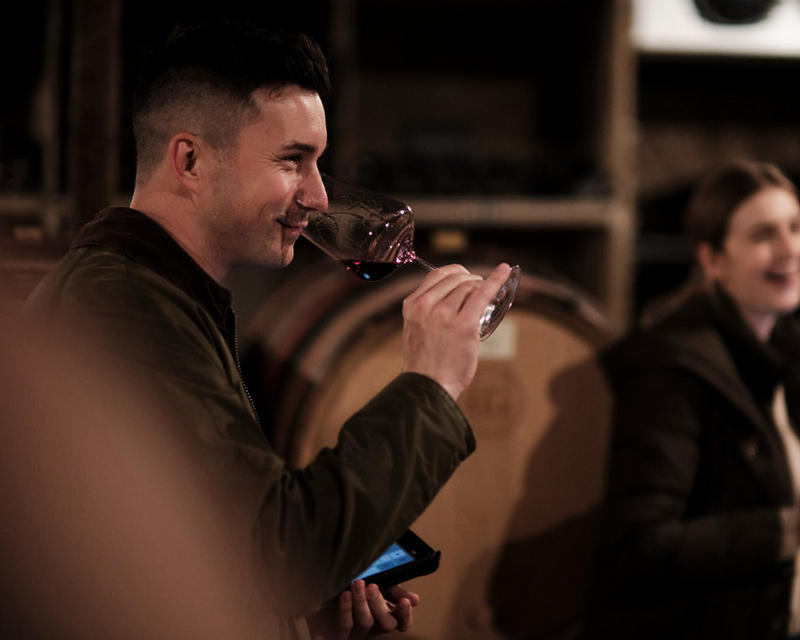Home > Editorial > Burgundy 2021 vintage report
10-MINUTE READ
A season of seemingly endless challenges has yielded a tiny crop with some standout wines, says Adam Bruntlett. Here, our Burgundy Buyer gives his verdict on what will be an unforgettable year.
The Burgundians won’t soon forget 2021, a year characterised by seemingly endless setbacks and challenges. It all began with catastrophic frost, followed by regular rain, localised hail, downy and powdery mildew and, finally, late-season rain (and, consequently, botrytis). The only saving grace was the warm and dry weather in late August and September that nudged the grapes to ripeness.
My colleagues and I spend a considerable amount of time on the ground in Burgundy. Each October, I spend several weeks in the region with our Wine Director, Mark Pardoe MW, visiting our growers, tasting and assessing the new vintage. While Mark and I were enthusiastic about the wines, the growers rarely raised the same level of excitement. Many were scarred by the troublesome growing season and found these wines difficult to love – at first. But from this dark period, wonderful wines have emerged.
The verdict on the whites has always been positive. While the earlier-budding Chardonnay suffered greater frost damage, the remaining grapes ripened uniformly. Volumes, however, are painfully low. Many cuvées are missing because there weren’t enough grapes to make them; losses of over 70% were not uncommon. The reds are perhaps the bigger success story. They seemed rather light and austere before barrel ageing but have undergone an extraordinary transformation – filling out and gaining significant weight and texture. Again, volumes are tiny, although some more fortunate areas yielded a crop in line with 2020.
In positive news: 2022 has yielded a good-sized crop. Though it doesn’t meet the maximum permitted yields, it provides some space for optimism. Nonetheless, the commercial reality is that demand far outstrips supply. And many estates are subject, either directly or indirectly, to the forces of the bulk market, which shows no signs of slowing down. Add the significant inflationary pressures on energy, labour and dry-goods costs, along with a weakening pound, and it is easy to see why prices have risen.
The challenge for us and our growers alike this year will be in allocating the meagre volumes of wine among loyal customers. I strongly recommend an open-minded and flexible approach to purchasing. You won’t be disappointed: the quality is very high, and this style of vintage is likely to become increasingly rare.
The major meteorological event was the frost which arrived around 6th April and lasted for several days. Spring frost is nothing new; what is new is the unseasonably warm weather which preceded the cold snap, encouraging the vines to start growing – leaving the nascent buds vulnerable.
This was accompanied by snowfall which exacerbated the damage; temperatures fell to -9°C in places. Burning “candles”, which bring the temperature up by a few degrees, had limited impact. Other countermeasures like wind turbines, helicopters, aspersion systems and heating cables worked to an extent, but the general feeling was that little could be done. Only those who had managed to prune their vines later than usual, in late March, could claim any true success.
Chardonnay is typically more precocious than Pinot Noir, so was harder hit by frost. Those parcels which are best exposed and therefore most advanced – typically the Premiers and Grands Crus on the mid-slope – were worse hit than the cooler, low-lying sites that lag behind. In Chablis, the frost descended from above, wiping out the Petit Chablis vineyards on the plateau and the jewels of the appellation, but leaving many village-level sites unaffected.
April was dry and sunny by historic standards, but night-time temperatures regularly dipped below freezing, causing the vines to shut down. A serious hailstorm hit parts of Gevrey-Chambertin in early May, causing significant damage to the strip of hillside vineyards from the Combe de Lavaux to Les Evocelles. The rest of spring and early summer were unusually humid, with regular rainfall until mid-August. Flowering took place in mid-June, a full month later than in 2020.
In these wet conditions, downy mildew began to spread; it was important to treat the vineyards regularly. Careful management of the foliage was key to ensuring good airflow and preventing the spread of disease from the leaves to the grapes. Powdery mildew (oidium) heaped on further misery. Cruelly, it has a penchant for Chardonnay – robbing more of the already scarce crop. Because they thrive in different weather conditions, rarely are the two types of mildew seen in the same year, but 2021 was exceptional.
The vintage was saved by the warm, dry weather from mid-August into September, accompanied by a breeze that kept diseases at bay and aided ripening. In a cruel twist, the rain returned (up to 45mm on 19th September), bringing with it the threat of botrytis.
This was a harrowing experience for the vignerons. It takes huge resolve to keep going, doing the vineyard work to ensure the following year’s crop has a decent chance of success, knowing all the while that the current crop will be painfully small.
Harvest began a month later than in 2020, usually around the weekend of 18th and 19th September. While the cooler conditions meant there was less pressure to pick quickly than in an August harvest, the rain on the 19th led to fears of botrytis spreading. Picking was therefore mostly complete by the end of September.
The season’s difficult conditions, along with the development of rot, necessitated careful sorting in the vineyard and the winery. This was particularly important for the red grapes, which spend longer in contact with the skins and so require more careful handling. After years of near redundancy, sorting tables were a key tool; some reported rejecting up to five percent of what they had picked. Such is the price of quality.
Unsurprisingly given the season’s more classic profile, the grapes analytically bore closer resemblance to vintages of yesteryear, with potential alcohol levels typically between 12 and 13 degrees, and often below. Yet most growers felt the grapes were ripe. This is almost certainly a consequence of the focus on quality over quantity, leading to lower yields than were achieved even 15 years ago. Had there been a full crop, such ripeness would not have been achieved.
Acidity levels were good, with low pH and a high proportion of malic acid compared to warmer years, when much of this is often burnt off by the warm, sunny conditions. The red grapes had relatively thin skins and there is a high proportion of millerandage in both colours – reflecting the challenging conditions at and before flowering.
After the relatively straightforward winemaking of 2020, this was a more challenging year. Conscientious winemakers always adapt their methods to the vintage and its fruit. With a markedly different fruit profile to much of the past decade, 2021 saw a change in tack for most. Almost all grapes came in below 13 degrees of potential alcohol; judicious use of chaptalisation was used to prolong fermentations.
With more modest levels of ripeness and the potential for some rot-affected fruit, producers took a gentle, hands-off approach to extraction for the reds. This avoided the risk of extracting bitter tannins from the skins that could overpower the delicate fruit flavours. Most favoured gentle pump-overs or old-style pushing down of the cap, rather than the more aggressive punching-down. However, some felt that with lighter wines, there was something to be gained by pushing harder, and have perhaps found an extra dimension, though these wines may be less approachable in youth.
Most growers used less new oak. This was partly a practical decision: taking new barrels with a short crop would mean selling good quality (but older) barrels or keeping them filled with water and sulphur for over a year – not ideal. Equally, with a relatively light vintage, some feared that too much oak would smother the wines. Others took a different approach, either as part of a house style or because new oak allows greater oxygen transfer than porous old barrels (and adds some sweetness). With wines of modest structure and complexity, some felt that new oak could add another layer. I was surprised by how well many of the 2021 wines took on new oak. Both approaches have been successful.
The high malic acid levels led to prolonged malolactic fermentations. This has lent the wines a softness that gives both reds and whites a pleasing, mouth-filling quality, ensuring they are fresh but not angular. Whole-bunch fermentation was a hot topic of conversation. Those who always practice 100% whole-bunch continued to do so – successfully. Others reduced the percentage of stems, feeling the stems or fruit were not ripe enough, risking the extraction of green tannins. A few increased the proportion of whole bunches, either for practical reasons (to fill tanks when there was so little fruit), or to de-acidify the wines and give more mid-palate sweetness. As with most things winemaking, confidence and conviction in one’s approach was as important as the approach itself. There is much to enjoy in all styles.
Producers reported just after harvest that this was principally a white-wine vintage – in quality terms, at least. Our expectations on tasting were therefore high, and it’s safe to say that these were met, if not exceeded. Sadly, there is so little available that it will be difficult to get one’s hands on them.
Many white yields came in at single-digit volumes per hectare, in contrast to a full crop of between 40 and 64hl/ha, for Grand Cru to regional-level wines respectively. Chablis, the Mâconnais, the Côte Chalonnaise and the Côte de Beaune were badly affected; nowhere was spared from frost. Village and regional wines fared better than Premier and Grand Cru, but Chardonnay is in very short supply.
I was keen to discover whether there were similarities to the most recent frost-affected vintage, 2016. The frost damage that year came later in the season than 2021, leading to uneven ripening and a mix of under- and over-ripe fruit at harvest. Thankfully, 2021 did not see this phenomenon; we did not pick up any of this character in our tastings. The wines are classically honed, with energy, freshness and clear terroir expression. I do not expect them to reach the highs of 2017 or ’14, but they should offer good short- and medium-term drinking.
Pinot Noir yields were marginally better than Chardonnay, particularly for parts of Morey-St Denis, the south and east of Gevrey-Chambertin and Beaune. There appeared to be little rhyme or reason, but pruning dates were important; those who managed to prune later had a larger crop. Alas it is impossible for all but the smallest domaines to prune every parcel in late March. Beaujolais did not escape the frost; yields are as small here as in the Côte d’Or.
While many referred to this (at least at first) as a “classic” vintage along the lines of 2007, or some vintages of the 1980s and ʼ90s, it became clear as we tasted that this is not the case. Yes, there is the freshness and lightness of those years of more modest levels of ripeness, but what was striking from our very first tasting was that these wines have a “modern” fruit profile and ripeness level. The fruit feels fully ripe, the tannins juicy and harmonious.
My most frequently used adjectives for the reds were “juicy” and “crunchy”. They are perfectly balanced, with sweet tannins, crisp acidity and modest alcohols, typically no higher than 13%. I adore the aromatic character; these are perfumed, expressive reds, bursting with floral notes and red berries. They are the kind of wines where you want to drink the perfume. Though not “light”, they do stand out from the recent run of vintages (2018-ʼ20). While many of the wines are wonderfully accessible now and should drink well in youth, the very best should age for a couple of decades. They will charm and delight lovers of Burgundian Pinot Noir; it was evident that many growers shared our enthusiasm for these filigree wines.






